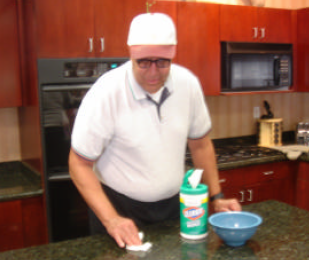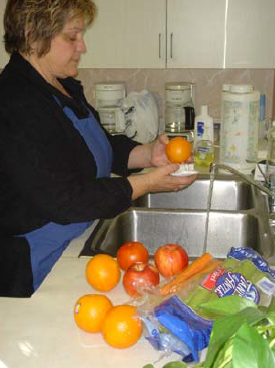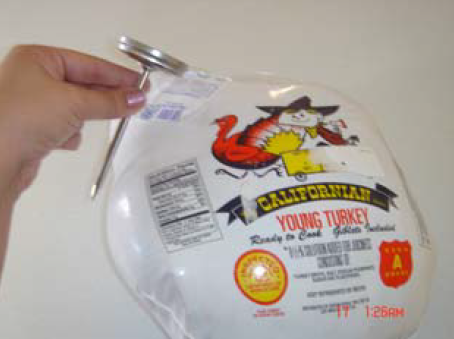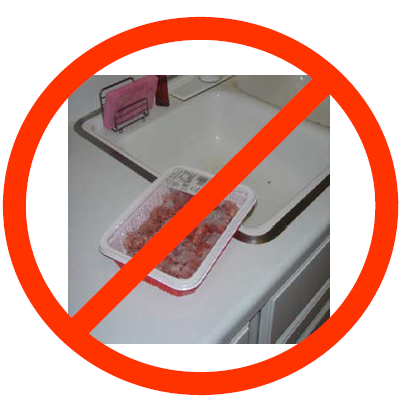Introduction
Eating contaminated food can cause a foodborne illness, even death, especially for older adults. To reduce your risk of what is commonly known as food poisoning, it is important to follow food safety techniques during food preparation, cooking, and storing.

Safe Food Preparation
- Avoid cross-contamination by using clean utensils, dishware, cutting boards, and be sure to wash your hands for 20 seconds.
- Wash all produce before eating it, including those with rinds that are not edible. Use a brush to carefully rinse and scrub fruits and vegetables under running water. Do not use bleach or soap, as these products may leach into food.
- NEVER thaw food on kitchen counters or at room temperature. Foods can be thawed in the refrigerator or in the microwave and then prepared to cook. Another option is to immerse the frozen food in cold water. Change the water every 30 minutes to maintain the cold temperature. However, this process can be complicated if you forget about the food left in the sink.
- Cook thawed food promptly.
- If you marinate foods be sure to do so in the refrigerator, not at room temperature on the counter. Never reuse marinades, breading or coatings on meats or vegetables. Throw them away after one use.
- Avoid “tasting” meat, poultry, eggs, fish, or shellfish when they are raw or only partially cooked.

Cooking
- Always cook foods to the proper temperature so that harmful bacteria are destroyed.
- Use a food thermometer for poultry, all types of meat (even ground beef), and casseroles, to ensure that foods have been cooked thoroughly, which can NOT always be determined by looking at the color of the cooked meat or the juices.
- When checking meat temperature, put the thermometer in the thickest, deepest part of the meat. Avoid placing the thermometer near the edge of the pan, near a bone, or in fat. You may have to hold burgers or chops sideways to get a proper temperature reading.
- Don’t interrupt cooking. Avoid cooking food partially to finish cooking later.
- Set the oven at 325° F or higher when cooking. Foods should not be cooked in the oven at a lower temperature.
| Raw Food |
Internal Temperature |
| Beef, Veal, Lamb (whole cuts) |
145° F with three minute rest time |
| Pork (chops, roasts, ribs) |
145° F with three minute rest time |
| Poultry (whole, pieces) |
165° F |
| Ground Meat/ Ground Poultry |
160° F /165° F |
| Seafood |
145° F |
| Egg Dishes |
160° F |
| Leftovers & Casseroles |
165° F |
More on Food Thermometers….
Most people think they can tell when food is done by just looking at it. Judging “doneness” based on color is misleading and can lead to food poisoning. According to recent USDA research, 1 out of every 4 hamburgers turn brown in the middle before it has reached a safe internal temperature. Types of food thermometers include: digital, dial or instant-read thermometers, barbeque forks, and probes for the microwave or oven.
It is the metal stem on the thermometer that acts as a heat conductor to produce a reading of the internal food temperature. Some types of thermometers are oven-safe though it is best not to leave them in the food and instead periodically check food temperature while cooking. Accurate readings can be produced within 10 seconds to 2 minutes depending on the type of food thermometer.

Serving Food Safely
- Keep foods warm after cooking by leaving them in the oven at 140° F. Cold foods should be kept at 40° F.
- Serve food on clean dishes with clean utensils rather than the ones used during cooking.
- After serving, refrigerate or freeze foods promptly.
Safe Storage of Food
- If a food package says, “keep refrigerated or frozen,” do so and store foods in specialized refrigerated compartments (i.e. vegetable crispers). Do not store perishable foods, like eggs, on the door shelves.
- Store leftovers in tight, shallow containers with an inch of airspace. Refrigerating or freezing immediately will allow food to cool evenly and quickly to a safe temperature. Divide large quantities into smaller ones for more convenient and safer food storage.
- Always label and date food, even take home foods. It is easy to forget how long something has been in the refrigerator or freezer!
- Fresh produce can be kept at room temperature or stored in the refrigerator or freezer. Storage times vary depending on the type of produce. Once fruits and vegetables have been cooked, refrigerate or freeze within 2 hours.
| Food Product |
Refrigerator (40° F) |
Freezer (0° F) |
| Eggs, fresh in shell |
4-5 weeks |
Don’t freeze |
| Milk |
1 week |
3 months |
| Chicken, fresh parts |
1-2 days |
9 months |
| Beef, fresh |
3-5 days |
6-12 months |
| Leftovers |
3-4 days |
3-4 months |
| TV Dinner |
Cook frozen |
3 months |
“When in doubt, throw it out”
- If food is obviously spoiled, moldy, or past its expiration date, throw it away. Do NOT try to determine safety by tasting the food as this can be dangerous.
- If you’ve had food longer than the “safe period,” you should throw it away: One to two days for meat, fish, and poultry; three days for casseroles and cooked vegetables.
- If the food has been left unrefrigerated for more than two hours throw it away, or after only one hour if stored at 90° F or higher.

Reference
- Fight BAC! : Four Simple Steps to Food Safety. USDA, FDA Revised Color Brochure, October 7, 2005.
- The Food Keeper: A Consumer Guide to Food Quality & Safe Handling. Brochure developed by Food Marketing Institute with Cornell University, Institute of Food Science, Cornell Cooperative Extension. Published 2002.
- Seniors CAN Curriculum, 2004 ed. Lesson Handouts FS-1: Food Safety, Part 1 & FS-2: Food Safety, Part 2.
- To Your Health! Food Safety for Seniors. FDA/USDA booklet, October 2000.
- Use a Food Thermometer. USDA/FSIS Brochure, Slightly Revised October 2003.
- USDA, Jan/Feb 1991; Revised July 2002. The Unwelcome Dinner Guest: Preventing Foodborne Illness. Publication no. FDA 00-2244.
- FoodSafety.gov (2012). Safe minimum cooking temperatures. Food Safety. Accessed 2/9/2012.
- For more information please contact Heidi Petermeier or Claudia Collins at (702) 222-3130.
Collins, C. and Petermeier, H.
2006,
Preparing, Cooking, & Storing Food Safely,
Extension | University of Nevada, Reno, FS-06-02


